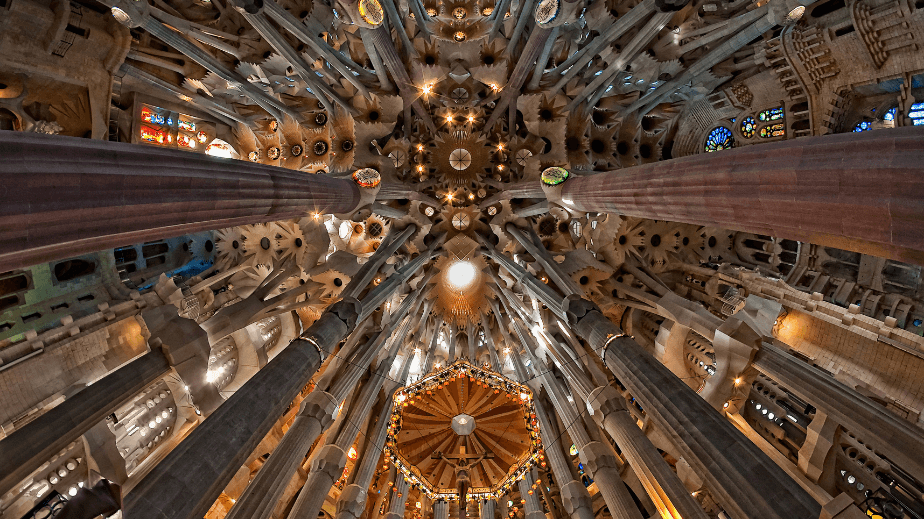Share This Article
Ask any architecture enthusiast about the Sagrada Família, and you’ll hear words like “iconic,” “breathtaking,” and “unfinished.” But wait—how can a building that began construction in 1882 still be incomplete in 2025?
That’s the magic, mystery, and maddening brilliance of the Sagrada Família, Barcelona’s most beloved architectural marvel.
Let’s unravel why this masterpiece by Antoni Gaudí remains a work-in-progress—and why that’s part of its enduring legacy.
A Dream That Started in the 19th Century
The Sagrada Família began as a relatively modest project—a standard neo-Gothic church. But when a 31-year-old architect named Antoni Gaudí took over the project in 1883, he radically reimagined the structure into something the world had never seen before.

© Through Eternity Tours
Inspired by nature, religion, and geometry, Gaudí’s vision was wildly ambitious: a church with 18 towering spires, 3 grand facades, and symbolism woven into every inch. He knew it wouldn’t be finished in his lifetime—and famously said:
“My client is not in a hurry.”
Yes, Gaudí was referring to God.
Why It’s Taking So Long
There are several reasons the Sagrada Família has taken over 140 years to build. Let’s break it down:
1. Gaudí’s Unique Design Is Complex—Really Complex
This is not your average basilica. Gaudí blended Gothic, Art Nouveau, and parametric forms long before computer-aided design existed. His plans involved complex geometries, organic motifs, and structural innovations that even today challenge modern construction techniques.
2. It Was Funded by Donations
The Sagrada Família wasn’t financed by the Church or government. From day one, it’s been built with money from private donations and ticket sales—which meant slow, incremental progress.
3. Gaudí Died in 1926—and Left Only Models
When Gaudí died (tragically hit by a tram), the church was only 15–25% complete. Worse still, many of his models, drawings, and plans were destroyed during the Spanish Civil War in 1936. Architects since then have had to reconstruct his vision from fragments and photos.
4. War, Politics, and Pandemics Slowed Construction
Spain’s civil unrest, economic downturns, and most recently, the COVID-19 pandemic, have all delayed progress. In fact, the church’s projected completion was pushed from 2026 (Gaudí’s centenary) to sometime after 2030.

© Basílica de la Sagrada Família
The Role of Technology in Reviving Gaudí’s Vision
In recent decades, digital modeling, 3D printing, and advanced engineering have drastically improved the pace of construction. What once required handcrafted stone can now be precision-carved in a fraction of the time.
Still, Gaudí’s architectural language is so layered and spiritual that replicating it with integrity takes more than machines—it takes interpretive skill and faith in his vision.
Also Read – How Architects Can Combat Climate Change: Strategies for Sustainable Design
Why People Still Love an Unfinished Masterpiece
Despite being incomplete, the Sagrada Família draws millions of visitors each year, making it one of the most visited monuments in Spain. People come not just to admire its towering spires or surreal interiors, but because the building represents something we rarely talk about in architecture: patience.
It’s a reminder that some visions are too big to fit in one lifetime. That sometimes, beauty is born out of delay. And that architecture isn’t just about what gets built—but about the stories we pass down.

Will It Ever Be Finished?
The goal now is to complete construction by the early 2030s, including the central Jesus Christ spire, which will make it the tallest church building in the world at 172.5 meters.
But even if that deadline is missed (again), maybe that’s okay. Because the Sagrada Família isn’t just a church—it’s a living cathedral, still growing, still evolving.
It’s not just finished. It’s eternal.
The story of the Sagrada Família is not about architectural failure—it’s about architectural devotion. It shows us what happens when design meets purpose, when spiritual vision guides construction, and when a city decides to finish what one man started over a century ago.
